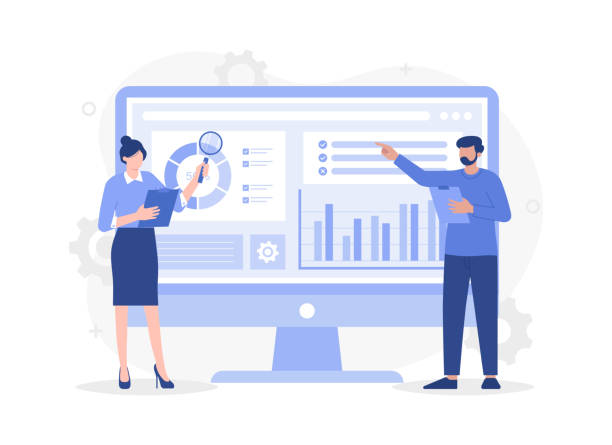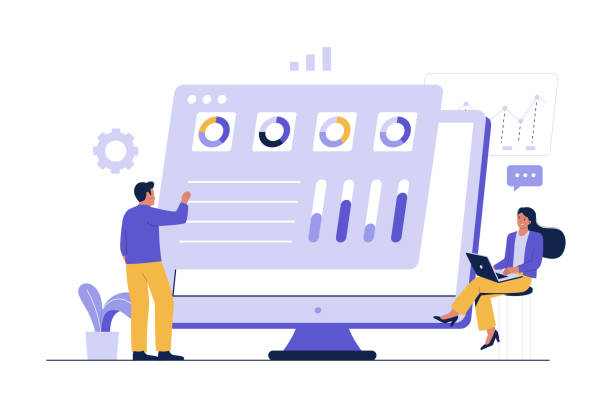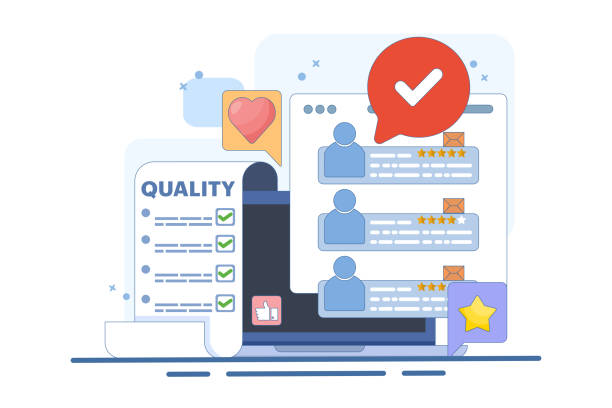Introduction to Multilingual Website Design and its Necessity

In today’s world, where geographical boundaries have less meaning in virtual space, #multilingual_website_design is no longer a competitive advantage, but a necessity for any global-oriented business.
When users from around the world visit your website, providing content in their native language not only greatly improves user experience (UX), but also increases a sense of trust and closeness.
Imagine a German-speaking visitor entering a website where all its content is in Persian; they will probably leave the site in less than a few seconds.
This is where the importance of multilingual website design shows itself.
Multilingual websites are a bridge between different cultures and languages, allowing you to convey your message to a wider audience.
This approach not only expands your target market beyond domestic borders but also helps you have an active and effective presence in international markets.
A multilingual website is a gateway to new global opportunities and multiplies your business’s potential for greater success.
This is an important step for any company looking to globalize and wants to connect with its customers on a deeper level.
The main goal is to increase accessibility, improve international SEO, and ultimately, achieve sustainable revenue growth.
Did you know that your company’s website is the first point of contact for 75% of potential customers?
Your website is the face of your brand. With **Rasaweb** corporate website design services, build an online presence that earns customer trust.
✅ Create a professional and lasting image for your brand
✅ Attract target customers and increase online credibility
⚡ Get free consultation from **Rasaweb** experts!
Competitive Advantages of a Multilingual Website

Building a #multilingual_website is not just about translating content; it is a #powerful_strategy for gaining sustainable competitive advantages.
One of the most important of these advantages is the significant increase in access to the global market.
By providing content in different languages, you can reach customers who were previously deprived of accessing your products or services due to language barriers.
This directly impacts site traffic and, ultimately, the Conversion Rate.
Studies have shown that users are more inclined to purchase or interact with websites that offer content in their native language.
In addition, multilingual website design greatly helps improve international SEO.
Search engines like Google prefer multilingual websites for display in local search results in different countries, which in turn leads to increased visibility and more organic traffic.
Another advantage is strengthening international credibility and branding.
A website that has been carefully translated and localized into different languages demonstrates your professionalism and commitment to serving customers worldwide.
This helps in #building_trust and loyalty among international customers.
Ultimately, in today’s competitive market, a company that can meet the linguistic needs of its audience will be a step ahead of its competitors and a leader in the path to #globalization.
These advantages not only help increase sales but also ensure the long-term sustainability and growth of the business.
Challenges and Solutions for Implementing Multilingual Website Design

Implementing #multilingual_website_design, despite its many advantages, also comes with challenges that require careful planning and correct execution.
One of the most important challenges is managing content and translating it into different languages.
Ensuring the quality of translations, maintaining the brand’s original tone and message in each language, and continuously updating content across all versions can be very complex.
To solve this problem, using Translation Management Systems (TMS) and collaborating with professional native-speaking translators is essential.
Another challenge is technical issues related to international SEO; such as the correct use of hreflang tags, appropriate URL structure for each language, and managing multilingual sitemaps.
Choosing the best URL structure (subdomains, subdirectories, or country-specific top-level domains) is also of high importance, each having its own advantages and disadvantages.
In addition, issues related to content localization, including converting units, date and time formats, and even colors and images according to local culture, can create complexities.
To overcome these challenges, #comprehensive_planning and the use of #appropriate_tools and experienced specialists in multilingual website design are crucial.
Below is a table of the most common challenges and their proposed solutions.
| Challenge | Proposed Solution |
|---|---|
| Quality and accuracy of translation | Using native-speaking translators and TMS tools |
| Multilingual content management | Employing a powerful Content Management System (CMS) and suitable plugins |
| International SEO optimization | Correct implementation of hreflang tags and appropriate URL structure |
| Cultural issues and localization | Consulting with local experts and thorough cultural research |
| Continuous maintenance and updates | Establishing a regular process for content review and updates |
Technical Approaches in Building Multilingual Websites

Choosing the #appropriate_technical_structure for #multilingual_support on a website is one of the key decisions in the #multilingual_website_design process.
There are three main approaches to organizing different language versions of a site: Subdirectories, Subdomains, and Country Code Top-Level Domains (ccTLDs).
Each of these methods has its own advantages and disadvantages that should be chosen based on business goals and available resources.
Subdirectories (e.g., yoursite.com/en and yoursite.com/fr) are usually the simplest and most common approach, and their SEO management is relatively easier because all languages are under one main domain.
This method is suitable for businesses that want to centralize their main domain’s traffic and authority for all languages.
Subdomains (e.g., en.yoursite.com and fr.yoursite.com) are another option that can be considered as independent sites by Google and can have separate SEO for each language.
This method is suitable for larger projects or when there is a need to host country-specific content independently.
Finally, ccTLDs (e.g., yoursite.de for Germany or yoursite.fr for France) give the strongest geographical signal to Google and are ideal for companies that want to have a completely local presence in each country and manage SEO completely independently, but their cost and management complexity are higher.
Choosing the right approach forms the foundation of success in multilingual website design and facilitates technical optimization for search engines.
This choice should be made carefully and after a thorough review of technical and SEO aspects.
Tired of losing customers due to poor e-commerce website design? With Rasaweb, solve this problem forever!
✅ Increase sales and conversion rate from visitor to customer
✅ Smooth and engaging user experience for your customers⚡ Get free consultation
The Importance of Localization and Cultural Adaptation in Multilingual Content

#Localization goes beyond mere text translation and means #complete_adaptation_of_content to the culture, customs, and expectations of local audiences.
In the #multilingual_website_design process, this aspect is of vital importance.
Localization includes changes in units of measurement, date and time formats, local currencies, images, and even colors to appear completely natural and appealing to audiences in a specific region.
For example, an image popular in one culture might cause misunderstanding in another.
Or, #using_the_appropriate_tone in the text, which varies in every language and culture, plays a key role in effective communication with the audience.
Ignoring localization can lead to an undesirable user experience and even damage brand reputation.
A website that has only been translated might appear unprofessional or even unintentionally disrespect cultural sensitivities.
Therefore, every successful multilingual website design process must include a detailed localization phase.
This phase requires #thorough_research on the target market and the use of native translators and specialists who are not only fluent in the language but also fully familiar with its culture and subtle differences.
Localization helps you establish a deeper and more meaningful connection with your international audience and strengthen their trust and loyalty.
SEO Optimization for Multilingual Websites
![]()
#International_SEO is an integral part of #multilingual_website_design and is vital for success in global markets.
Without a proper SEO strategy, even the best translations and localizations cannot reach the target audience.
One of the most important elements in multilingual SEO is the correct use of hreflang tags.
These tags help search engines like Google identify the correct version of a page based on the user’s language and geographical region and prevent duplicate content issues.
Choosing the appropriate URL structure (subdirectory, subdomain, or ccTLD) also impacts international SEO.
Keyword research for each language separately and considering cultural and dialectal differences, is an essential step.
Keywords that are effective in one language may have a different meaning in another or not be used at all.
In addition, building backlinks from local and reputable websites in each country can help increase the site’s authority and ranking in that region.
Site loading speed, mobile compatibility, and overall user experience (UX) are also important factors that should be considered across all language versions.
All these actions signal to search engines that your website values international audiences and provides relevant, high-quality content.
A #comprehensive_and_precise_SEO_strategy for each language guarantees the visibility and success of your multilingual website in global search results.
Translation Management Tools and Content Management Systems

For #efficient_multilingual_content_management and simplifying the #multilingual_website_design process, using specialized tools and Content Management Systems (CMS) with multilingual capabilities is essential.
Translation Management Systems (TMS) such as MemoQ, SDL Trados, and Smartling are powerful tools that help companies manage the translation process from start to finish.
These systems offer features such as Translation Memory, Termbase for maintaining terminology consistency, and translation workflows that help #increase_speed and #reduce_translation_costs.
On the other hand, many popular CMSs like WordPress (with plugins like WPML and Polylang), Drupal, and Joomla, offer built-in features or powerful plugins for supporting multilingual websites.
WordPress, with plugins like WPML, allows you to easily create and manage different language versions, translate content, and even optimize SEO for each language.
Drupal is also designed with a multilingual approach from the ground up and has strong capabilities for managing multilingual content.
Choosing the right CMS and combining it with an efficient TMS can turn the complex process of multilingual website design into a smooth and organized experience.
These tools are vital for maintaining the coherence, quality, and up-to-dateness of all language versions of your site.
| Popular CMS | Multilingual Plugin/Feature | Key Features |
|---|---|---|
| WordPress | WPML, Polylang | Easy translation management, support for various content types, SEO compatibility |
| Drupal | Core built-in capabilities | Multilingual by core, powerful capabilities for large sites, high flexibility |
| Joomla | Built-in capabilities, JoomFish | Easy management of menus and content in different languages |
| Magento | Built-in capabilities for multilingual stores | Suitable for e-commerce, support for local currencies and taxes |
User Experience and User Interface in Multilingual Website Design

#User_Experience (UX) and #User_Interface (UI) play a vital role in the success of a #multilingual_website.
Designing a website that is understandable and appealing to users from different cultures and languages requires special attention to detail.
One of the basic principles is the ability to select language clearly and easily.
The language selection button or menu should be placed in an accessible location with a familiar icon (e.g., country flag or ISO language code).
Also, the design must be flexible to properly display texts of different lengths in various languages, without distorting the page layout or losing readability.
Issues related to text direction (such as right-to-left languages like Persian and Arabic) should also be considered, and the website design must correctly support RTL (Right-to-Left).
Additionally, #fonts must be supported for all languages and have good readability.
Colors and icons may also have different meanings in different cultures, so they must be chosen carefully.
The ultimate goal in #multilingual_website_design is for every user, regardless of their language or culture, to have a smooth, natural, and enjoyable experience on the website.
This significantly helps #increase_engagement, reduce Bounce Rate, and ultimately achieve business goals.
Are you tired of losing business opportunities due to not having a professional corporate website?
Rasaweb, with professional corporate website design, helps you:
✅ Build a powerful and reliable image for your brand
✅ Convert site visitors into loyal customers
⚡ Get free consultation now!
Review of Successful Examples and Future Trends in Multilingual Website Design

A look at #successful_examples in #multilingual_website_design can be inspiring and illuminate the future path.
Large companies like Google, Amazon, and Booking.com operate globally and have successfully optimized their websites for users of various languages and cultures.
They not only provide accurate translation but also pay special attention to deep content localization, technical and service support in the local language, and precise international SEO strategies.
Future trends in multilingual website design are also very exciting.
With advancements in Artificial Intelligence and Machine Learning, higher quality automatic translation tools and more advanced localization capabilities are expected to be developed.
This can make the translation process faster and more cost-effective, though human oversight will still be necessary to maintain accuracy and tone.
#Voice_search and #AI-powered_interactive_systems will also play an increasing role, which increases the need for multilingual support for voice inputs.
Additionally, increased use of #multilingual_visual and video content, including automatic subtitles and dubbing, is another important trend.
These advancements promise a future where #reaching_global_markets will become increasingly easy and widespread.
Businesses must be prepared to embrace these new technologies to stay ahead in global competition.
Conclusion and Next Steps for Your Multilingual Website Design Project

In this article, we comprehensively examined #various_aspects_of_multilingual_website_design and showed how this approach can help businesses #expand_their_global_presence and #increase_revenue.
From competitive advantages and implementation challenges to technical approaches, the importance of localization, international SEO strategies, practical tools, and user experience considerations, all are important aspects to be considered.
#Designing_a_successful_multilingual_website goes beyond simple text translation; this process requires a deep understanding of cultures, technologies, and international marketing strategies.
To start your multilingual website design project, the next steps include: first, #identifying_target_markets and required languages, then #choosing_the_appropriate_technical_structure for the site, and subsequently #planning_for_content_management and the translation and localization process.
Investing in appropriate tools and collaborating with experienced specialists in SEO and localization can make a big difference in the success of your project.
Is your business ready to take this big step towards globalization? Have you identified the hidden potentials in international markets for your growth? With careful planning and correct execution, your #multilingual_website can become one of your business’s most valuable assets and help you on the path to sustainable growth and achieving global goals.
Frequently Asked Questions
| Question | Answer |
|---|---|
| What is multilingual website design? | It is designing a website whose content is available to users in several different languages, so that users can choose their desired language. |
| Why is a multilingual site important? | To reach international audiences, increase site traffic, improve user experience for non-Persian speaking visitors, and expand business in global markets. |
| What are the benefits of having a multilingual site? | Increased international SEO, attracting new customers from different countries, enhancing business credibility and professionalism, and reducing bounce rate by providing understandable content. |
| What are the methods for implementing a multilingual site? | Using subfolders (e.g., example.com/en/), subdomains (e.g., en.example.com), or separate top-level domains for each language (e.g., example.com and example.de). |
| Which URL structure is best for international SEO? | Subdirectories (like example.com/en/) are often preferred for SEO due to consolidating the main domain’s authority, although each method has its advantages and disadvantages. |
| How does a multilingual site affect SEO? | By providing content in different languages, the site appears in local search results for those languages, click-through rates and traffic increase, and the overall domain authority of the site improves. Correct use of hreflang tags is very important. |
| How is content translation managed? | One can use professional translators, machine translation tools (with human editing), or Content Management Systems (CMS) with built-in multilingual capabilities or relevant plugins. |
| What are common challenges in multilingual website design? | Managing translated content, maintaining design consistency across different languages, compatibility with right-to-left (RTL) languages like Persian and Arabic, optimizing SEO for each language, and choosing an appropriate URL structure. |
| How do I manage text direction (LTR/RTL) in a multilingual site? | For right-to-left languages (like Persian), you need to apply specific CSS styles to change text direction, element layout, and table direction. Often by using the property direction: rtl; and other related settings. |
| How can users change the site language? | Typically by using a button, dropdown menu, or language selector widget clearly placed in the header or footer of the site. Automatic detection of the user’s browser language and suggesting a language change is also common. |
And other services of Rasaweb Advertising Agency in the field of advertising
Smart Custom Software: An innovative service to increase user engagement through user experience customization.
Smart Digital Branding: Transform online growth with custom programming.
Smart Conversion Rate Optimization: Revolutionize click-through rate increase with marketing automation.
Smart Direct Marketing: A combination of creativity and technology to attract customers through intelligent data analysis.
Smart Data Analysis: A combination of creativity and technology for user interaction through marketing automation.
And over hundreds of other services in internet advertising, advertising consultation, and organizational solutions
Internet Advertising | Advertising Strategy | Advertorial
Sources
Advantages of Multilingual Site Design
Importance of Multilingual Site in Global Market
How to Design a Multilingual Site?
Impact of Multilingual Site on SEO
? Are you ready for your business to leap forward in the digital world? Rasaweb Afarin Digital Marketing Agency assists you on your growth path by providing innovative solutions in e-commerce website design, SEO, social media management, and branding. For a free consultation and to learn more about our services, contact our experts today.
📍 Tehran, Mirdamad Street, next to Central Bank, Southern Kazeroun Alley, Ramin Alley No. 6


